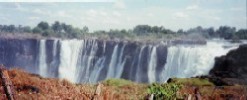
welcome to
SAfricaVoyage.com

|
| Home Articles Headlines Links Feedback Link to us Free update About us |
Swaziland, easily accessible from South Africa, has about one million inhabitants, known as Swazis, who speak Siswati, wear colourful tribal robes and who make exquisite sculptures and carvings. Swaziland is one of three kingdoms in Africa - the other two being Morocco and Lesotho. (Photo of Swazi tribal dress: Peter Shark, French phtographer)
Since it is completely surrounded by South Africa this kingdom is entirely dependent on its predominant neighbour for its trade, imports and exports and for its economic survival.
It was during the years of 1750s that Swazis descendants Nguni tribes in South Africa migrated northwards towards KwaZulu-Natal on the east coast before moving further northwest to Ususthu River escape powerful and notorious King Shaka Zulu his armies. The area, particularly north of the river, proved to be a good refuge because of its many mountains, and the Swazis remained there. The original Swazi kingdom was once twice as large as it is today and what is left of the kingdom gained its independence from Britain in 1968 thanks to the efforts of the previous monarch, King Sobhuza II.
At ceremonies and festivals the Swazis sport their costumes of scarlet, white and black robes, red feathers and bright necklaces and knobkerries (big cane walking sticks) lances and shields. There are several annual ceremonies, the most famous being the Incwala and the Umhlanga.
The previous Swazi king, King Sobhuza II, had 48 wives and 100 mistresses and it is often jokingly quipped that the poor man died of fatigue. This egg-shaped kingdom offers a diversity of countryside and has one of the best climates in the world. The high veldt in the north is mountainous and there are numerous gorges and rivers and many lovely waterfalls and streams running over rocks, particularly in the rainy season. Heavy mist often envelops the mountainous regions making visibility and driving along steep passes quite precarious. Nearer the centre of the kingdom and the capital cities of Mbabane and Manzini, are vast, fertile green plains and the royal Ezulweni Valley (valley of Heaven) where the king and his wives and children reside in palaces, hidden from public view. The climate here is sub tropical but on descending further south the countryside becomes almost arid and very dry with many thorn trees and sugar cane farms, watered by the Usuthu River that meanders among the hills. While artefacts attract many tourists, the principal product of Swaziland is forestry, pines and eucalyptus (blue gum) and sugar cane. It also has rich asbestos and iron deposits. Gold was found in Swaziland in 1883 by a Frenchman, believed to be Monsieur Piguet or a similar French name, shortened to 'Pigg', near the present village of Pigg's Peak in the north of the country. Gold valued at around $10 million in today's value was mined there until 1954 when the mine closed. One anecdote goes that Monsieur Pigg closed up his mine, hid the entrance of it and went off in search of other adventures. When he returned after a number of years absence he found the whole area covered in forests and was unable to find the opening to his mine. So it's believed there is still a fortune of gold waiting to be dug up in the Swazi hills. At Pigg's Peak there is a lovely hotel and casino of the same name, which also offers swimming and horse riding nearby. Southeast in the Ezulweni valley there is the Royal Swazi hotel and casino, which offers golf and a spa and the most divine buffets of fish and game, and a wide range of rich desserts. For animal lovers there are three small game reserves, though my favourite is Mlilwane near the Royal Swazi hotel, where one can see tame buck, warthog and birds at close range - in fact they even come into the courtyard outside the overnight chalets, which is wonderful for photographers. This reserve once had a tame hippo called Somersault that used to steal the birds' food, but who also endeared himself to all the tourists when he performed in the lake. A visit to Swaziland is not complete without stops at the candle and glass factories, where one can buy lovely Swazi candles or recycled glass shaped into cute animals such as, hippos, elephant, rhino, giraffe and birds. Another must is the market in Mbabane or the one in Manzini, both offering superb artefacts, such as Swazi cloths or robes, ornaments, wooden and stone carvings and beautiful Swazi baskets. Additional information: The Swazi currency emalangeni is on a par with the South African Rand (about $1 equals 10 emalangeni) and so for overseas foreigners souvenirs, hotel accommodation and restaurants are inexpensive. Swazi currency, however, is not acceptable, nor can it be exchanged for other currencies in most Southern African countries, so it is wise to spend all one's change in the kingdom. Credit cards are accepted. A word of warning: there are many mosquitoes, particularly in the hot summer months of October to March and tourists are advised to take necessary precautions. The easiest ways to get to Swaziland by road are to travel northwest from Durban in South Africa to reach the Golela border post, or after a trip to the Kruger National Park in the Mpumalanga Province of South Africa, go through the Oshoek or Bulembu border posts. There are flights from Johannesburg and from main towns, like Nairobi, Lusaka, Dar Es Salaam and Harare, in other African countries.
|
Sponsored by: |
||||||||
|
| ||||||||||
| Link to
this site. Feedback. All contents copyright © 2001,2002, all rights reserved. 1:26 |
|
This site is hosted by Interprise. | ||||||||